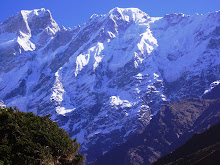The Himalaya Range (Sanskrit: literally, "abode of snow", हिमालय, IPA pronunciation: [hɪ'mɑlijə]), or Himalayas for short, is a mountain range in Asia, separating the Indian subcontinent from the Tibetan Plateau. By extension, it is also the name of a massive mountain system that includes the Karakoram, the Hindu Kush, and other, lesser, ranges that extend out from the Pamir Knot.
Together, the Himalayan mountain system is the planet's highest and home to the world's highest peaks, the Eight-thousanders, which include Mount Everest and K2. To comprehend the enormous scale of this mountain range, consider that Aconcagua, in the Andes, at 6,962 metres (22,841 ft) is the highest peak outside Asia, whereas the Himalayan system includes over 100 mountains exceeding 7,200 m (23,622 ft).[1]
The Himalayan system, which includes outlying subranges, stretches across six countries: Afghanistan, Bhutan, People's Republic of China, India, Nepal, and Pakistan. Some of the world's major rivers, the Indus, the Ganges, the Brahmaputra, and the Yangtze, rise in the Himalayas, and their combined drainage basin is home to some 1.3 billion people, including the people of Bangladesh. The Himalayas have profoundly shaped the cultures of South Asia; many Himalayan peaks are sacred in both Hinduism and Buddhism.
The main Himalaya range runs, west to east, from the Indus river valley to the Brahmaputra river valley, forming an arc 2,400 km (1,491 mi) long, which varies in width from 400 km (249 mi) in the western Kashmir-Xinjiang region to 150 km (93 mi) in the eastern Tibet-Arunachal Pradesh region. The range consists of three coextensive sub-ranges, with the northern-most, and highest, known as the Great or Inner Himalayas.
Wednesday, February 24, 2010
Subscribe to:
Post Comments (Atom)

No comments:
Post a Comment